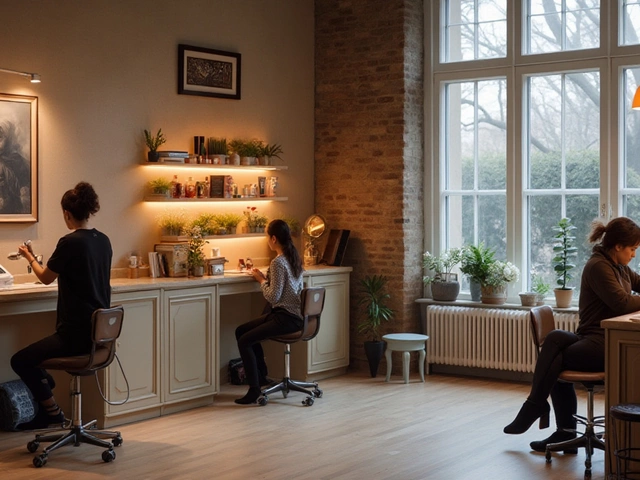If you’re asking what makes the most money, you’re really asking two things: which treatment commands the highest price per hour, and which one you can legally, safely, and confidently deliver in your area. The top earners in 2025 are non-surgical aesthetics (for medics), scalp micropigmentation, permanent makeup, and laser. But the highest earner for you depends on budget, licensing, marketing, and what you can get booked solid. I live in Bristol and see this play out across salons and aesthetics rooms every week-pricing is only half the story; repeatability, safety, and trust do the heavy lifting.
What are you trying to get done after clicking this? Probably one or more of these jobs: pick the single best-paid beauty course for your situation; sanity-check real numbers (prices, setup costs, ROI); understand UK rules and insurance; avoid overpaying for training; and map a fast route to profit without burning out.
TL;DR: The highest-earning beauty qualifications in 2025
If you want a straight answer, here it is-split by background.
- If you’re medically qualified (doctor, dentist, prescribing nurse): Anti-wrinkle injections and dermal fillers are top of the income tree. Typical UK pricing: £180-£300 for anti-wrinkle areas, £220-£450+ per ml of filler. A focused injector doing 8-12 treatments a day can gross £1,500-£3,000 on busy days. You need proper medical training, prescription pathways, and tight governance.
- If you’re non-medical: Scalp Micropigmentation (SMP) gives the best single-client revenue in the beauty/aesthetics-adjacent space. £1,200-£3,000 per client over 2-3 sessions is common, with low consumables and strong demand from men and women. Permanent Makeup (PMU)-brows, eyeliner, lips-also pays well: £250-£500 per treatment plus annual top-ups. Laser/IPL hair removal and skin rejuvenation scale fast if you can finance the device and build repeat packages.
- High-margin but accessible add-ons: Advanced skin (microneedling, chemical peels, radiofrequency) delivers £120-£300 per hour with routine repeat bookings. Lash lifts and extensions, brow lamination, and spray tans won’t top the charts per appointment, but they stack with volume and membership models.
Reality check: The “best-paid” course only wins if you can fill your diary. A £2,000 SMP course beats a £15,000 laser if you can start booking SMP clients within a month. Flip that around, and a clinic with footfall and finance can make laser the cash cow via packages and prepaid plans.
How to choose the best-paid path (step-by-step, with rules of thumb)
Use this quick decision path to pick your route without second-guessing.
- Check your eligibility and legal scope.
- Medics: You can train in injectables. Botox is prescription-only; you need a prescriber pathway and must follow UK advertising rules (ASA/CAP) that ban promoting prescription-only meds to the public. Promote “anti-wrinkle injections,” not “Botox.”
- Non-medics: Focus on SMP, PMU, laser/IPL, and advanced skin. For PMU and microblading, many UK councils require a Special Treatments Licence. For laser, some councils license Class 3B/4 devices; check your local authority. The Government has confirmed a new licensing scheme for non-surgical cosmetic procedures-expect roll-out from 2025-26. Insurers follow recognised training standards (e.g., HABIA frameworks, JCCP guidance).
- Match demand to your market, not social media hype.
- Walk your area (or search local adverts) and count: how many SMP artists within 10 miles? How many PMU artists? What do they charge? Are they fully booked?
- In cities like Bristol, Manchester, Leeds, SMP and PMU keep steady waitlists; laser demand surges when clinics push 6-8 treatment packages and interest-free finance.
- Do the maths before you buy training or kit.
- Simple income formula: Income per month ≈ Price per treatment × treatments per week × 4.2 − direct costs.
- Capacity rule: New practitioners average 40-60% utilisation in the first 3 months; aim for 70-80% by month 6 with good marketing.
- Price sanity check: If your price is >20% above top local artists without clear differentiation, expect slower bookings. Build value first, then raise.
- Pick the shortest route to safe, bankable bookings.
- Low-cost, high-ROI first: microneedling, peels, lash lift, brow lam. Then “ladder up” into PMU, SMP, or laser once cash flow is steady.
- If you can finance and have footfall, laser/IPL scales best with packages and cross-selling skin protocols.
- Train with a provider your insurer recognises.
- Ask for: accreditation (e.g., CPD, HABIA-aligned), trainer’s portfolio and complication management track record, small class size, live models, and aftercare support.
- Get a written confirmation from your target insurer that they cover that qualification and device model.
- Pre-sell before you qualify.
- Run a waitlist, collect enquiries, and offer founding-client pricing for your first 10-20 models (with consent, photos, and clear aftercare).
- Bank 5-10 deposits before committing to big kit purchases.
Quick heuristics (useful when you’re stuck):
- 1-day course + low kit cost + repeat-friendly = fastest payback (microneedling, peels).
- High ticket + low consumables + longer sessions = best hourly rate (SMP, PMU).
- Device-led + package sales = best scale (laser/IPL, RF).
- Medical-only = highest ceiling but tighter rules (injectables).
Regulatory and safety notes (UK focus): Botox is prescription-only; fillers are medical devices but treated with similar caution. Non-surgical cosmetic licensing is being introduced following the Health and Care Act 2022-keep an eye on Department of Health and Social Care updates. Local council licensing (especially in London) applies to special treatments and lasers. Insurers often reference HABIA standards and the JCCP/CPSA guidance for aesthetics. The ASA/CAP advertising codes prohibit the promotion of prescription-only medicines to the public. All of this affects what you can offer and how you market it.

Earnings breakdown, ROI and real-world numbers (UK focus)
Here’s how the most profitable courses stack up on price, time, and realistic utilisation. These figures reflect typical 2025 pricing I see across UK cities and large towns. Your exact numbers may vary-use them as working assumptions for your own plan.
| Course/Treatment | Typical Training Cost | Setup/Kit Cost | Client Price (UK) | Time per Client | Weekly Capacity (solo) | Revenue/week @70% utilisation | Key Constraints |
|---|---|---|---|---|---|---|---|
| Scalp Micropigmentation (SMP) | £2,000-£4,000 | £1,000-£2,000 | £1,200-£3,000 (2-3 sessions) | 6-9 hrs total | 2-3 new clients | £2,520-£6,300 | Precision, long sessions, niche marketing |
| Permanent Makeup (PMU) - Brows | £2,000-£5,000 | £1,000-£2,000 | £250-£500 + top-up | 2-3 hrs | 10-12 | £1,225-£2,100 | Licensing/insurance; strong portfolio needed |
| Laser/IPL Hair Removal | £1,500-£4,000 | £12,000-£60,000 (device) | £30-£250 per area; £600-£1,200 per package | 15-60 mins | 30-40 sessions | £2,520-£5,880 | Finance, council licence, maintenance |
| Advanced Skin (Microneedling) | £300-£800 | £300-£1,000 | £120-£250 | 45-60 mins | 20-25 | £1,176-£2,187 | Repeat plans drive profit |
| Advanced Skin (Chemical Peels) | £300-£900 | £300-£800 | £80-£200 | 30-45 mins | 20-30 | £1,120-£1,960 | Patch testing; brand training matters |
| Lash Extensions (Classic/Hybrid/Volume) | £200-£600 | £200-£500 | £55-£100 | 1.5-2.5 hrs | 15-20 | £721-£1,400 | Time-heavy; retentions are key |
| Lash Lift + Brow Lamination | £150-£400 | £150-£300 | £35-£70 | 45-60 mins | 20-30 | £490-£1,050 | Great as add-on or membership |
| Injectables (Medics) | £1,500-£4,000 per module | £1,000-£3,000 | £180-£300 (anti-wrinkle area); £220-£450+/ml filler | 20-45 mins | 20-30 | £3,150-£6,300 | Prescription rules; advertising restrictions |
Notes on the table:
- Revenue/week assumes an established practitioner at 70% utilisation (a realistic target after 3-6 months). New starters often sit at 40-60% while they build reviews and referrals.
- SMP sits high due to low consumables and strong client value. Appointments are long, but the ticket price compensates.
- Laser can overtake everything when you sell 6-8 session packages and run two rooms or a stacked diary. Finance and local licensing are the gatekeepers.
- PMU delivers a great blend of high price, manageable kit costs, and evergreen demand-if your portfolio is strong.
- Advanced skin is the stealth earner: lower price per session, but clients come monthly, which protects your base income.
ROI snapshots (how fast can you get in the black?):
- SMP: £4,000 training + £1,500 kit = £5,500. Two clients at £1,800 each nearly cover it. Most artists recoup within 4-8 clients.
- PMU Brows: £3,500 all-in. Ten clients at £350 recoup your investment, often within 6-10 weeks if you’ve pre-sold models.
- Laser: £20,000-£40,000 device + £3,000 training. Sell 50 entry-level packages at £600 and you’re covered; a clinic with footfall can do that in 4-6 months with marketing. Solo operators may need 9-12 months.
- Microneedling: £1,200 all-in. Six to ten clients at £150 puts you into profit. This is why it’s a brilliant first step.
Pricing realities I see on the ground around Bristol and the South West:
- PMU brows commonly £300-£395 with a 6-8 week top-up included or priced at £50-£100.
- Laser packages close best at 20-30% off RRP when prepaid, with a 0% finance option.
- Microneedling bundles at 4-6 sessions drive retention and upsell to peels and LED.
- SMP attracts clients willing to travel across counties for well-documented results and healed photos.
Safety and credibility lift your price more than fancy decor. Publish healed results, aftercare, contraindications, and patch-testing protocols. Clients will pay more for practitioners who educate and follow strict hygiene. Insurers and regulators like BABTAC, HABIA, and JCCP say the same for a reason.
Checklists, pitfalls, and your next steps (with mini‑FAQ)
Short checklists you can copy into your notes today.
Business and compliance checklist (UK):
- Confirm your council’s Special Treatments Licence rules (especially for PMU, microblading, laser).
- Choose training your insurer recognises; get written confirmation before paying.
- Set up treatment consent, medical history, and aftercare forms (digital is fine).
- Patch test policy in writing (brand-specific where required).
- Sharps and clinical waste contracts if applicable; documented infection control.
- ASA/CAP-safe marketing: don’t advertise prescription-only medicines; use compliant wording.
- Professional indemnity + public liability insurance, treatment-specific cover.
- Device registration/servicing logs for laser/IPL.
Marketing checklist to fill your first 50 slots:
- Build a 9-grid portfolio before launch: 3 pre-draw/mark-up shots, 3 procedure shots, 3 healed results.
- Offer “founding client” pricing for the first 10-20 bookings in exchange for photos/reviews.
- Run a waitlist with a small, non-refundable booking fee and a clear cancellation policy.
- Partner locally: hair salons, barbers (SMP), bridal boutiques (PMU), gyms (laser). Profit-share beats cold ads early on.
- Record short videos explaining contraindications and aftercare-trust beats discounts.
Pricing and retention checklist:
- Anchor your price at the local top 25% if your portfolio matches; start mid-market otherwise and raise every 10-15 reviews.
- Package repeat treatments (microneedling, peels, laser) into 4-8 session plans with prepayment.
- Offer maintenance memberships: example, “Glow Club” at £49-£79/month for quarterly peels + monthly LED add-ons.
Common pitfalls that kill profit:
- Buying a laser on credit before you have leads or a pre-sold list.
- Skipping healed photos-clients buy outcomes, not in-procedure glam shots.
- Underestimating how long SMP/PMU sessions take when you’re new. Book buffer time.
- Breaking ASA rules on injectables ads and getting your account restricted.
- Training with the cheapest provider, then learning insurers won’t cover you.
Pro tips from the treatment room:
- Double your perceived value with simple upgrades: numbing comfort, curated aftercare kits, and honest pre-treatment education.
- Batch your day: laser blocks, PMU day, skin day. You’ll work faster and reduce set-up time.
- Track re-bookings and no-shows weekly. Aim for 65%+ rebook on skin services; SMP/PMU should generate at least one referral per three clients.
Mini‑FAQ
- What’s the single most profitable course for non‑medics? If you want high ticket in few sessions, Scalp Micropigmentation. If you want steady bookings with strong upsell, Permanent Makeup or Laser/IPL.
- How fast can I make my money back? Microneedling and peels: sometimes in your first month. PMU: 6-10 weeks with pre-sold models. SMP: 4-8 clients. Laser: 4-12 months depending on your marketing and finance.
- Do I need a licence for PMU/microblading? In many UK councils, yes-a Special Treatments Licence. Always check your local authority.
- Can non‑medics do injectables? Non-medics can attend some courses, but access to prescription-only medicines is restricted, and insurers often require medical qualifications. Follow JCCP/CPSA guidance and speak to your insurer.
- Are there advertising rules? Yes. The ASA/CAP codes prohibit promoting prescription-only medicines (like Botox) to the public. Keep your marketing compliant.
Next steps by persona
- If you’re brand new with £1,000-£2,000 budget: Start with microneedling and peels. Build a small base, gather 20+ reviews, then add PMU or SMP. You’ll learn consultation, consent, and aftercare without heavy finance.
- If you’re a brow/lash artist with a loyal base: Add PMU brows first. Your clients already trust you. Pre-sell 20 spots at a founding price, document the journey, then add lips/eyeliner or laser hair removal.
- If you’re a medic moving into aesthetics: Train in anti-wrinkle and filler with a reputable clinical trainer, set clear clinical governance, and keep airtight complications protocols. Add skin boosters and polynucleotides later. Keep ads compliant.
- If you’re a salon owner with footfall: Finance a proven laser/IPL device, train two staff, and sell packages with 0% finance. Pair with a skin membership for off-peak hours.
Troubleshooting (common snags and fixes)
- “I’m not getting enquiries.” Fix your proof. Post healed results, before/afters, and a 30-second explainer for each treatment. Add a booking link and a waitlist.
- “People say I’m too expensive.” You’re probably priced above your proof. Either add evidence (reviews, case studies, clinician profile) or use a founding-client offer with limited spots.
- “I can’t get insured for my course.” Ask the insurer which accreditations they accept, then train with providers on that list. Don’t pay until you have written confirmation.
- “Laser finance is scary.” Start with advanced skin to build cash flow, then lease a mid-tier, clinic-proven device with a servicing plan. Pre-sell 30 packages before the device arrives.
The money answer you came for is simple: injectables for medics; SMP, PMU, and laser/IPL for non-medics. The smarter answer is to pick the one you can fill consistently, market credibly, and deliver safely in your postcode. Nail that, and the income takes care of itself.





Write a comment